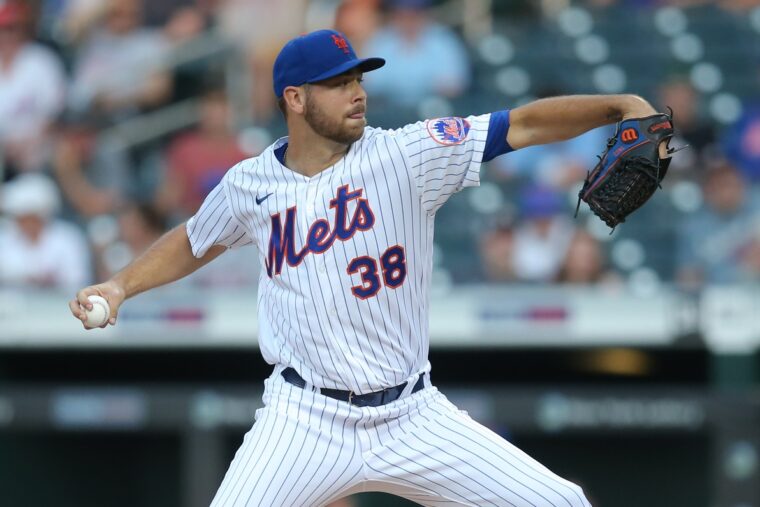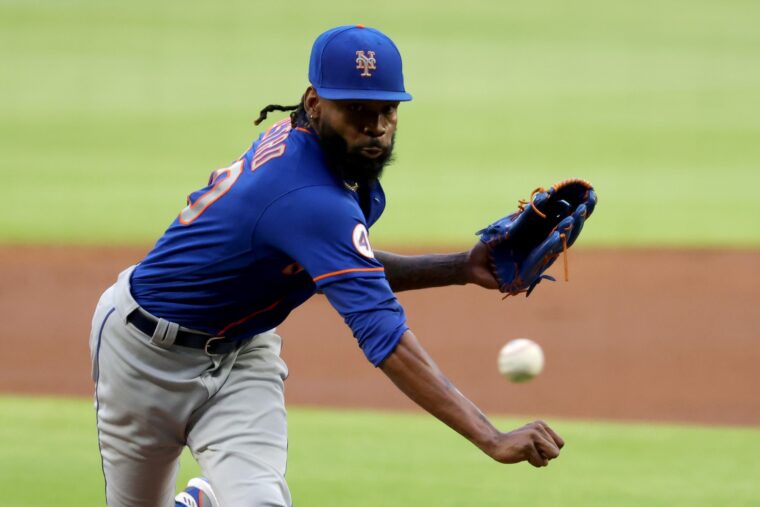
Mandatory Credit: Brad Penner-USA TODAY Sports
We’re now more than halfway through the season, and the Mets have been in first place for two months uninterrupted. They’re 45-38 with seven games in a row coming up against the Pittsburgh Pirates–one of the worst teams in baseball, though their offense, powered by Ke’Bryan Hayes, has looked a bit better of late.
An injury-riddled first half is thankfully coming to an end soon, but the Mets were able to take two-of-three from a fellow first-place team in the Brewers this week. Let’s look at some ups and downs from the series.
3 Up
Fighting Back Against Good Pitchers
The Mets were down a run to both Brandon Woodruff, Corbin Burnes and Josh Hader–three of the best pitchers in baseball–and they were able to scratch out timely walks and hits against all three in the first two games of the series. (What can’t be lost in these situations are the pitchers who kept the Mets in these games: Tylor Megill and, of course, Jacob deGrom.)
The Mets scored four total off Woodruff, one immediately after the Mets went down 1-0 and three more while the game was tied in the seventh. The Mets also immediately responded off Corbin Burnes with a run when they went down 1-0 in the first on Wednesday.
Most shocking of the comeback runs was probably José Peraza’s game-tying, pinch-hit dinger off Hader in Game 1’s final frame. Well, it was surprising for all of us not named Marissa.
if this is a true 2021 mets game jose peraza would somehow hit a pinch hit homer off hader in the 7th
— Marissa (@marissamets) July 7, 2021
Tim Britton of The Athletic also wrote a really good article that touched on Peraza’s splits in low, medium and high leverage situations. If it’s felt like he’s come up clutch before, it’s because he’s performed best this year in high leverage situations.
Contrary to the rest of offensive situations, where the Mets are generally in the bottom five in terms of OPS and scoring, the Mets are eighth in the league in wRC+ at 103 (the offense as a whole as a 92 wRC+) and middle of the pack in OPS in high leverage situations, which FanGraphs defines as situations with a leverage index over 2.0. Leverage index takes into account the score, inning and according to FanGraphs.
McNeil Getting In The Groove
Jeff McNeil was 7-for-38 (.184 AVG) with no walks (.184 OBP) in his first 12 games back off the injured list. Since then, in his last six games, including two full games and a pinch hit appearance against the Brewers, McNeil is 6-for-15 (.400 AVG) with three walks (.500 OBP).
His biggest hit came in Game 1 of Wednesday’s doubleheader when he knocked a curveball 101 miles-per-hour up in the middle to score the tying and winning runs. It was the first game-winning hit of McNeil’s career, but more importantly, it was an indication McNeil was seeing the ball–and hitting the ball–better.
His first month of the season, like many Mets’, was pretty poor. McNeil was turning it around in the first two weeks of May (.302 AVG, .806 OPS) before he got injured, though, and the hope is his last six games show he’s back on track.
How About Tylor Megill, Folks?
In Tylor Megill first three starts, he’s allowed six runs in 14.1 innings (3.77 ERA) at a time the Mets have been desperate for competent starting pitching at the back end of the rotation.
He hasn’t just offered competency, though, he’s offered solid outings that have kept the Mets in games. Through the three starts, his highlights have been a fastball that averages 95 miles per hour and a useful slider that’s racking up whiffs and poor contact. He has a 32.2 strikeout percentage, which would sit right between Gerrit Cole and Trevor Bauer in the top 10 of qualified starters.
Megill’s shown solid poise for not playing above Double-A, though he was pretty clearly the Mets’ most MLB-ready arm at 25 years old. If the Mets didn’t need a starter over the last two weeks, he would’ve been up in Triple-A by now. Megill’s development is encouraging for a rotation that will need depth in 2022 with various top-end contract expiring. He’ll likely be back down in Triple-A within a month or so, especially if the team acquires a starter, but it’s been great to see his ability to handle hitters

Mandatory Credit: Jason Getz-USA TODAY Sports
3 Down
Damned Doubleheaders
The weather struck the Mets again this series, causing yet another doubleheader for the team. They’ve now played in nine doubleheaders, resulting in 36 less scheduled innings played. No other team has played more than five. There have been 35 doubleheaders across baseball this year, and the Mets have played in a quarter of them. They have two more scheduled across July and August, as well.
Ten of the team’s cancellations have been because of weather, and another three were due to the Nationals’ COVID-19 situation at the outset of the season. Whatever the reason, the pushbacks have messed up the Mets’ rotation plans more than once, including this week. Rather than get two full starts from Jacob deGrom before the All-Star break, they got one Wednesday and they might get a couple innings Sunday.
The cancellations actually helped at the beginning of the year as the team was largely able to work with a four-man rotation for most of April. But as the season goes along, you can’t put all that stress on the top three guys (deGrom, Marcus Stroman and Taijuan Walker), and these cancellations, increase of spot starts needed and the general taxing of the bullpen catch up to a staff.
Scoring With The Bases Loaded
HOW did the Mets not score with the bases loaded and no out in the sixth of Game 2 Wednesday with Francisco Lindor, Dominic Smith and Pete Alonso up? Three straight strikeouts from the heart of the order with the bases loaded resulted in no runs and kept the Mets down 3-0 heading into the final frame.
If it’s felt like the Mets have struggled with the bases loaded this year, it’s because they have. They’re one of two teams in the majors without a grand slam. They’ve had 75 at-bats with the bases loaded this year (ninth in MLB). They’ve scored just 52 runs (18th in MLB)–15 of the 52 came on walks or hit-by-pitches. Over those 75 at-bats, they have 12 singles and four doubles. They’re also: 28th in OPS with the bases loaded, dead-last in slugging and sixth in strikeouts.
This follows the general trend of the offense, which struggles to score runs in most situations. The hope is the offense performs differently in the second half, and they’ll start to hit better with the bases loaded with that.
Miguel Castro Is Really Struggling
Miguel Castro was one of the Mets’ best relievers over April and May. He was used a lot by Luis Rojas, though, and it seems like the work is catching up to Castro.
The 26-year-old gave up seven earned runs in 25 innings and 23 appearances through June 6. Since then, he’s allowed eight runs in 8.2 innings, including two in Game 2’s final inning. Early June has become a line of demarcation for pitchers this season as that’s around when Major League Baseball teased a memo regarding a crackdown of foreign substances.
Castro’s spin rate isn’t down over that time, but his walk rate has ballooned. Through his first 25 innings, he walked 13 batters. In his last 8.2 innings, he’s walked nine, so he’s totally reverted back to the control issues that marred him over the first couple years of his career.
Also around this time, though, Castro was dealing with a neck issue. He left his June 11 appearance with a stiff neck, got four days off and pitched 10 times since then. There’s also totally the possibility the injury knocked him off something mechanically that he hasn’t fixed yet. We’ll see if the All-Star break will help Castro regain his composure.















